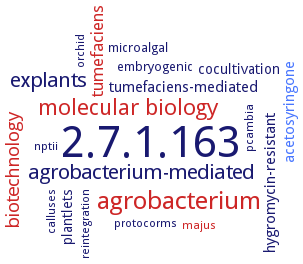2.7.1.163: hygromycin B 4-O-kinase
This is an abbreviated version!
For detailed information about hygromycin B 4-O-kinase, go to the full flat file.

Word Map on EC 2.7.1.163 
-
2.7.1.163
-
agrobacterium
-
molecular biology
-
agrobacterium-mediated
-
explants
-
biotechnology
-
tumefaciens
-
tumefaciens-mediated
-
hygromycin-resistant
-
acetosyringone
-
plantlets
-
cocultivation
-
microalgal
-
embryogenic
-
pcambia
-
majus
-
nptii
-
protocorms
-
calluses
-
orchid
-
reintegration
- 2.7.1.163
- agrobacterium
- molecular biology
-
agrobacterium-mediated
-
explants
- biotechnology
- tumefaciens
-
tumefaciens-mediated
-
hygromycin-resistant
- acetosyringone
-
plantlets
-
cocultivation
-
microalgal
-
embryogenic
-
pcambia
- majus
- nptii
-
protocorms
-
calluses
-
orchid
-
reintegration
Reaction
Synonyms
Hm phosphotransferase, HPH, Hph5, HPT, hptII, hygromycin B phosphotransferase, hygromycin B4-O-phosphohygromycin, hygromycin phosphotransferase, hygromycin-B kinase, hygromycin-phosphotransferase, HyR
ECTree
Advanced search results
Cloned
Cloned on EC 2.7.1.163 - hygromycin B 4-O-kinase
Please wait a moment until all data is loaded. This message will disappear when all data is loaded.
Agrobacterium tumefaciens strain EHA101 containing the plasmid pIG121-Hm which harbored intron-containing beta-glucuronidase gene under the control of a 35S cauliflower mosaic virus promoter, hygromycin phosphotransferase gene, and neomycin phosphotransfease gene as reporter genes is used for transformation.
-
by Agrobacterium-mediated transformation. Spores of Marchantia polymorpha are germinated and grown into immature thalli. The 7-day-old immature thalli are co-cultivated with Agrobacterium and transferred directly to selective M51C agar medium after washing. Incubation of immature thalli with Agrobacterium harboring the binary plasmid pIG121Hm lead to the formation of hygromycin-resistant plantlets, whereas Agrobacterium carrying no binary plasmid did not. Hygromycin-resistant thalli with rhizoids became distinct 10 days after transfer to the selection agar medium, whereas hygromycin-sensitive plantlets developed into chlorotic cell clumps. To avoid chimerism of hygromycin-resistant thalli, isogenic lines are obtained from gemmae which arise asexually from single initial cells in cupules, and used for further analysis.
-
Co-transformation of Oryza sativa L. var. Pusa Basmati1 was done using an Agrobacterium tumefaciens strain harbouring a single-copy cointegrate vector and a multi-copy binary vector in the same cell. The T-DNA of the cointegrate plasmid pGV2260::pSSJ1 carried the hygromycin phosphotransferase and beta-glucuronidase genes. The binary vector pCam-chi11, without a plant selectable marker gene, harboured the rice chitinase gene under maize ubiquitin promoter.
-
DNA sequence determination and analysis, overexpression of His-tagged enzyme in strain DH5alpha in inclusion bodies
-
Embryogenic culture of Alfalfa plant is transformed using Agrobacterium tumefaciens containing the super binary plasmid pToK233 that encodes for the neomycin phosphotransferase II, hygromycin phosphotransferase and glucuronidase genes in order to design an antibiotic resistant line.
-
Expression of hph5 gene in Escherichia coli (strain BL21) and expression of selenomethionine-substituted enzyme in the methionine-auxotroph Escherichia coli strain B834 (DE3)
-
gene hph, subcloning in strain DH5alpha, expression in Neurospora crassa 74-OR23-IVA and al-1,mcm
-
gene hph, subcloning in strain JM109, expression of wild-type and mutant enzymes in Thermus thermophilus strain HB27, establishment of the host-vector system using the hpt gene as a selective marker
-
hph5 gene is introduced into Thermus thermophilus on a plasmid of eight copies. HPH and HPH5 are PCR amplified and Escherichia coli strain BL21 (DE3) is transformed with the plasmids and cultivated.
-
hyg-gene introduced into different sites of both the Escherichia coli plasmid pBR322 and the Escherichia coli-Saccharomyces cerevisiae shuttle vector YRp7. When this gene is inserted into the BamHI site of pBR322 and then cloned in Escherichia coli phosphorylating activity is not detected. When the hyg gene is inserted into either the unique PstI site of the pBR322 or into each of the two PstI sites of YRp7, phosphotransferase activity is observed
-
hygromycin B resistance gene is cloned in pBR322, recombinant plasmids pKC241 pKC222 carrying the resistance
-
in Colletotrichum falcatum and Colletotrichum acutatum. Agrobacterium tumefaciens-mediated transformation (ATMT) is used by using the vector pBHt2 that contains a t-DNA harboring the hygromycin B resistance gen (hygromycin phosphotransferase, hph) in the backbone of pCAMBIA1300.
-
Linearized DNA of plasmid pV2 bearing the hygromycin B phosphotransferase (hph) gene is inserted into chromosomes of wild strain T23 resulting in improved capability of degrading organophosphate pesticide dichlorvos. Transformation is confirmed by PCR and Southern blot analysis. 76% of transformants show improved dichlorvos degradation ability as compared to the parent strain T23
-
Physical parameters for transient transformation are optimized using the UidA gene encoding beta-glucuronidase as the reporter gene and with hygromycin-phosphotransferase (hptII) gene as selectable marker
-
Producing many transgenic cyclamen plants. Agrobacterium tumefaciens strain LBA4404 harbors the binary vector plasmid pIG121Hm, which contains selectable marker genes for hygromycin phosphotransferase and neomycin phosphotransferase is used for transformation.
-
Reproducible procedure for transformation of shoot apices and regeneration of transgenic plants for two indica rice cultivars. Shoot apex explants are transformed by cocultivation with Agrobacterium tumefaciens strain EHA 101 harbouring the binary plasmid pRIT1. Vector contains an improved hygromycin phosphotransferase gene for hygromycin resistance driven by actin 1 promoter and the reporter gene beta-glucuronidase intron controlled by CaMV 35S promoter.
-
subcloning in strain DH5alpha, overexpression of non-tagged enzyme in strain BL21(DE3) in inclusion bodies, method optimization, expression in transgenic rice plants
-
The hpt coding region is obtained by a XhoI digestion of the vector pCAMBIA1380 and is cloned into the SalI-cut pBluescript KSII. The EcoRV-XhoI fragment of the hpt coding sequence is ligated with the SmaI-XhoI fragment of pHAG to obtain the intermediate plasmid pHyII, so that the hpt coding region is flanked by the 2.3 kb ASA2 promoter at the 5'end and the Arabidopsis actin2 terminator at the 3'end. Finally, the SacI-SacII fragment of pHyII is ligated into the SacI-SacII-cut pBluescript KSII to complete the transformation vector pXZIII-8.
-


 results (
results ( results (
results ( top
top





